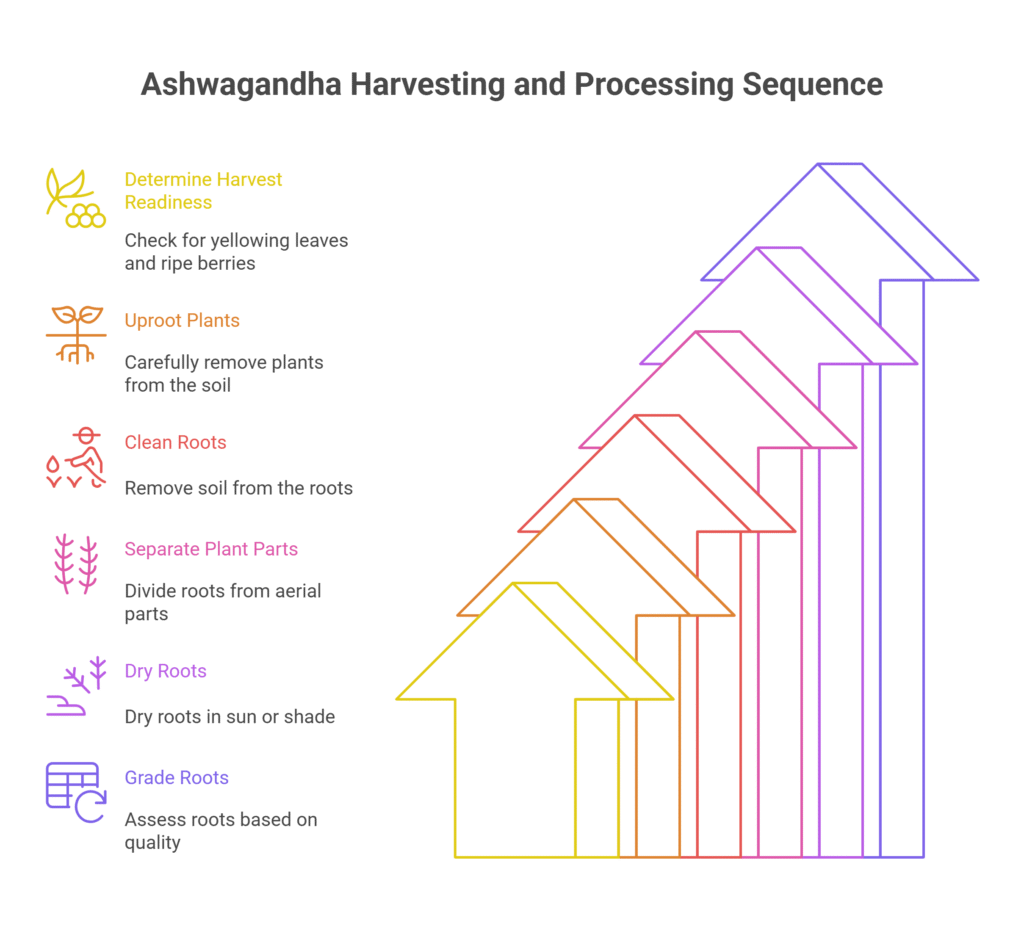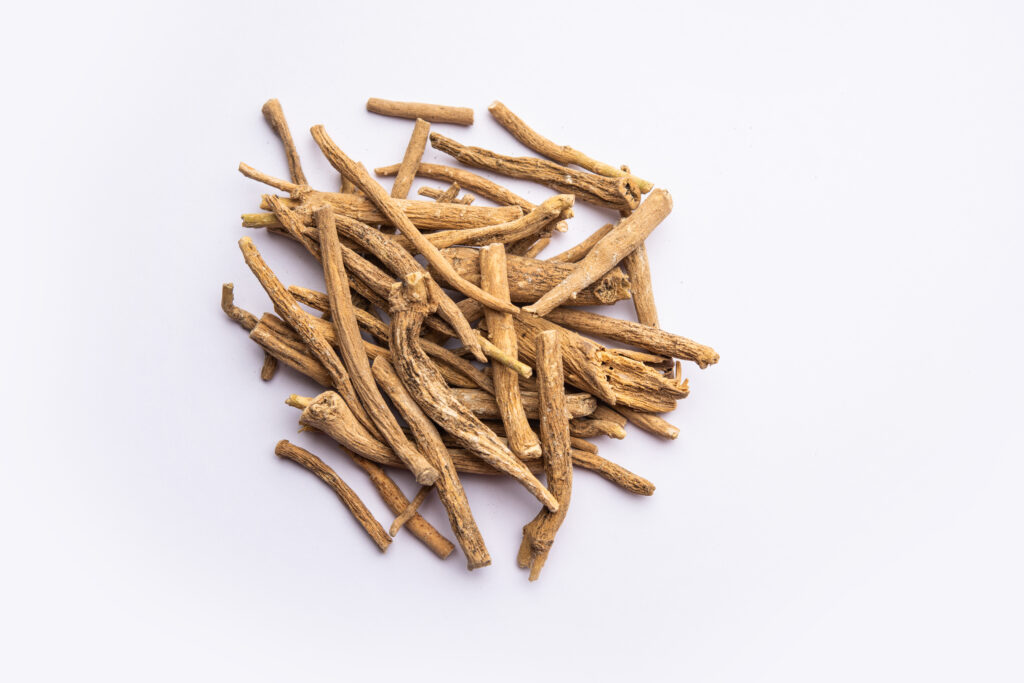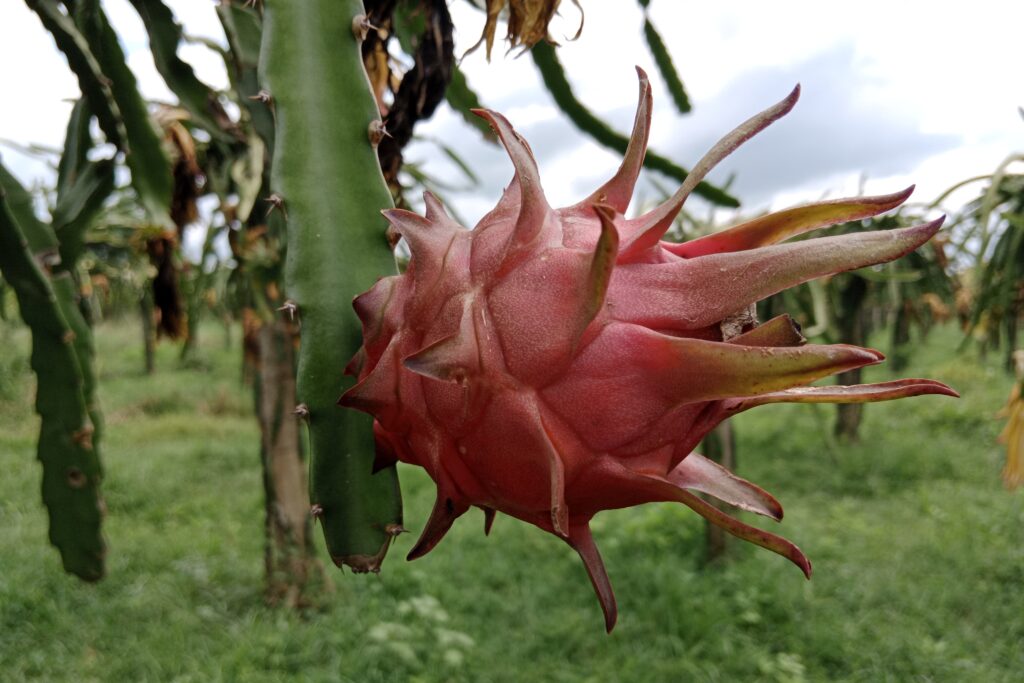Ashwagandha Farming
Ashwagandha is a renowned rejuvenating herb in Ayurveda, with its roots, seeds, and leaves used in both Ayurvedic and Unani medicine. The root is commonly used to treat rheumatic pain, joint inflammation, nervous disorders, epilepsy, and as a tonic for hiccups, colds, coughs, female health issues, ulcers, and age-related weakness.
Its leaves are applied to treat swellings and carbuncles, and the juice is helpful in conjunctivitis. The decoction of the bark is used for asthma and healing bedsores. Ashwagandha is also widely used in the preparation of herbal teas, powders, tablets, and syrups.

The profitability analysis of Ashwagandha farming profit per acre reveals a highly lucrative opportunity for growers. With a total investment cost of NRs 36,000 per acre, the cultivation yields a total income of NRs 286,000, resulting in a substantial net profit of NRs 250,000. This significant return demonstrates the economic potential of Ashwagandha cultivation, especially when managed with proper agronomic practices and inputs.
The return on investment (ROI) is calculated using the formula (Net Profit ÷ Total Cost) × 100, which in this case equals (250,000 ÷ 36,000) × 100 ≈ 694.44%. This exceptionally high ROI confirms that Ashwagandha farming profit per acre can be nearly seven times the initial cost, making it a highly rewarding venture for farmers seeking sustainable income from medicinal crop cultivation.
Land Preparation
Land preparation requires a well-pulverized, leveled, and well-drained soil to ensure optimal crop growth. It begins with deep ploughing (20–25 cm) using a mouldboard plough to break hard pans and improve soil aeration, followed by 2–3 cross harrowings to break down clods and achieve a fine tilth.
During the final harrowing, 5–10 tonnes per acre of well-decomposed Farm Yard Manure (FYM) or compost should be incorporated to enhance soil fertility. The field must be cleared of weeds and previous crop residues, and in areas susceptible to waterlogging, raised beds should be prepared for better drainage.
Soil Type
The crop thrives best in sandy loam to light red laterite soils with excellent drainage, as waterlogged conditions can lead to root rot. It can tolerate slightly alkaline soils, with an optimal pH range of 7.5 to 8.0, but does not perform well in saline or highly acidic soils.
Climatic Requirements
| Parameter | Requirement |
| Climate Type | Tropical/Subtropical, drought-hardy |
| Season Preference | Relatively dry season during growth & maturation |
| Optimal Temperature | 20°C to 35°C |
| Frost Sensitivity | Highly sensitive (cannot tolerate frost) |
| Rainfall | Moderate: 600-750 mm annually |
| Rainfall Risks | Susceptible to damage from heavy rains or prolonged wet periods |
| Critical Period | Requires a distinct dry period post-monsoon for root development and harvesting |
| Sunlight | Full sun to partial shade (prefer sunny conditions) |
Major Cultivars
| Variety Name | Key Features |
| JA-134 | High root yield, high withanolide content, drought-tolerant |
| Rakshita | High-yielding, adaptable, good root: shoot ratio |
| Poshita | High withanolide content |
| WS-20 | Suitable for Maharashtra conditions |
| Narendra Ashwagandha-1 (NA-1) | High root yield, high withanolide-A content |
| Local Landraces | Locally adapted; variable yield and alkaloid content |
| Jawahar Asgand-20 | High alkaloid variety, short plant height, suited for dense planting, matures in 180 days, ~0.30% withanolide |
| Jawahar Asgand-134 | High alkaloid variety, short plant height, suited for dense planting, matures in 180 days, ~0.30% withanolide |
| Raj Vijay Ashwagandha-100 | Developed for improved yield and quality |
| WSR | Improved variety from CSIR |
| Nagori | Known for its starchy roots |
Seed Rate per Acre
For Ashwagandha cultivation, a seed rate of 4-5 kg per acre is recommended for direct sowing. Seed treatment is crucial for enhancing germination. Seeds should be treated with Trichoderma viride (4-6 g/kg of seed) or Pseudomonas fluorescens (10 g/kg of seed) for disease prevention, followed by soaking in water for 12-24 hours before sowing.
Nursery Management
Before sowing, the land should be ploughed using a mould board plough and harrowed twice to achieve a fine tilth, while incorporating ample organic matter to enrich the soil. Treated seeds are then sown on raised nursery beds above ground level. The seeds typically germinate within 5–7 days and become ready for transplantation in about 35 days. Before uprooting the seedlings, the nursery should be adequately watered to ease removal, and transplanting should be carried out in the main field using 40 cm wide furrows.
Planting
a) Planting Season
| Condition Type | Planting Season | Timing | Key Details |
| Rainfed | Kharif | June–July | Sown with the onset of monsoon rains. |
| Irrigated | Spring/Summer | February–March | Dependent on local climate & water availability. |
| Autumn | September–October | Often yields better roots; optimal dry period post-monsoon for root maturity. |
b) Spacing
A spacing of 30 cm between rows and 20 cm between plants within each row is recommended, as it ensures sufficient root development and makes intercultural operations easier to carry out.
c) Planting Method
| Planting Method | Procedure | Critical Notes |
| Direct Sowing | Line Sowing (Preferred) · Seeds sown in shallow furrows (1–2 cm deep) · Opened at recommended spacing · Lightly covered with soil | · Ensures uniform plant distribution · Facilitates better crop management |
| Broadcast Method · Seeds are scattered randomly (less efficient) | · Higher seed rate required · Uneven spacing; not recommended | |
| Transplanting | Nursery Phase · Seeds sown in nursery beds 4–6 weeks before main planting Field Transfer · Seedlings transplanted at 4–6 leaf stage · During cooler hours (evening) · After rain/light irrigation | · Requires careful taproot handling · Reduces transplant shock |
d) Number of Plants per Acre
Based on a spacing of 30 cm by 20 cm, approximately 67,450 plants are required per acre to ensure optimal plant population and uniform growth.
Intercropping
Intercropping is a common practice during the initial 2–3 months of Ashwagandha cultivation to maximize land use and help conserve moisture and provide shade for young seedlings. Suitable intercrops include short-duration, upright, non-climbing crops such as legumes like green gram (moong), black gram (urad), and cowpea (lobia); millets like foxtail millet; and early-harvest vegetables like onion, radish, and coriander. However, tall, dense, or highly nutrient- and water-demanding crops should be avoided as they compete excessively with Ashwagandha.
Irrigation
| Aspect | Details |
| Critical Growth Stages for Irrigation | · Germination/seedling establishment · Root development stage |
| First Irrigation | · Immediately after sowing (direct) or transplanting |
| Subsequent Irrigation | · Every 10–15 days in summer (adjust based on soil moisture & weather) · Reduce frequency as plants mature |
| Pre-Harvest Irrigation | · Stop completely 3–4 weeks before harvest to enhance root maturity & alkaloid concentration |
| Irrigation Methods | · Common: Furrow / Flood irrigation · Recommended Efficient Method: Drip irrigation |
Fertilizer and Manure
The crop has low nutrient requirements and does not need heavy doses of manures or fertilizers. However, it responds well to organic inputs, and the application of 6–8 tonnes of well-decomposed farmyard manure (FYM) per acre is recommended for optimal growth.
| Application Stage | Type | Material/Component | Quantity per Acre | Timing/Notes |
| Basal Dose (At Planting) | Organic | Well-decomposed FYM/Compost | 5–8 tonnes | Incorporated during land preparation |
| Neem Cake | 250–400 kg | – | ||
| Biofertilizer | Azotobacter/Azospirillum | As recommended | – | |
| Phosphorus Solubilizing Bacteria (PSB) | As recommended | – | ||
| Inorganic | Phosphorus (P₂O₅) | 6 kg | Approx. 37.5 kg Single Super Phosphate (SSP) | |
| Top Dressing | Inorganic | Nitrogen (First Split) | 3 kg | Applied at 30–35 days after sowing (DAS) |
| Nitrogen (Second Split) | 3 kg | Applied at 60–70 DAS |
Weed Control
Weed control is crucial during the first 2–3 months of Ashwagandha cultivation, as the seedlings establish slowly and are vulnerable to competition. Manual weeding is commonly practiced, with 2–3 sessions recommended: the first at 20–25 days after sowing (DAS), the second at 40–45 DAS, and a third, if necessary, at 60–65 DAS, while avoiding deep hoeing near the plants to protect their shallow roots.
Mulching with organic materials like paddy straw or dried leaves, or using plastic mulch, helps suppress weed growth and conserve soil moisture. For chemical control, Pendimethalin may be applied as a pre-emergence herbicide, though post-emergence herbicides are generally not recommended.
Flowering and Fruit Management
Flowering in Ashwagandha begins around 60–70 days after sowing (DAS) and continues thereafter. For varieties cultivated primarily for root production, pinching or topping is a vital practice; removing the apical bud (top 1–2 cm) between 60–75 DAS redirects the plant’s energy from flowering and seed formation towards root development, resulting in enhanced root biomass and quality.
However, if the crop is grown for seed production, pinching should be avoided. In such cases, berries should be allowed to fully ripen on the plant, turning red or orange, and seed-bearing branches should be harvested when 70–80% of the berries are mature.
Pest and Disease Management
Common Pests
a) Root-Knot Nematode (Meloidogyne incognita)
Root-knot nematode (Meloidogyne incognita) is a major pest that causes galls or knots on roots, leading to stunted growth and yellowing of plants. Management includes crop rotation with non-hosts like marigold or sorghum, soil solarization, application of neem cake, use of biocontrol agents such as Paecilomyces lilacinus and Pochonia chlamydosporia, and planting resistant cultivars.
b) Spider Mites & Aphids
Spider mites and aphids are sap-sucking pests that become more problematic during dry weather, causing plant weakening and reduced growth. Effective management includes spraying neem oil at 0.5%, soap solution, or applying acaricides and insecticides such as Dicofol or Acephate at 1–2 ml per litre of water in severe infestations. Additionally, a foliar spray combining 0.5% Malathion and 0.1%–0.3% Kelthane at 10–15-day intervals has proven highly effective in controlling aphids, mites, and other insect attacks.
c) Mealybugs
Mealybugs are occasional pests that can affect Ashwagandha plants by sucking sap and causing plant stress. They can be managed effectively by spraying neem oil and removing the infested plant parts to prevent their spread.
Common Diseases
a). Damping Off (Pythium, Rhizoctonia, Fusarium)
Damping off, caused by soil-borne fungi such as Pythium, Rhizoctonia, and Fusarium, primarily affects Ashwagandha seedlings in the nursery, leading to rotting at the base of the stem, wilting, and eventual collapse of young plants.
Effective management includes treating seeds with biological or chemical agents like Trichoderma, Thiram, or Captan at a rate of 2 grams per kilogram of seed before sowing. Additionally, raising well-drained nursery beds and avoiding overcrowding of seedlings help reduce humidity and disease spread, ensuring healthy seedling establishment.
b) Leaf Spot (Alternaria alternata)
Ashwagandha is vulnerable to several fungal, bacterial, and viral infections, with leaf spot caused by Alternaria alternata being a common issue that leads to discolored spots, weakening plant health and reducing yield. For effective prevention and control, it is advised to spray the crop with Dithane M-45 at 3 grams per litre of water starting 30 days after sowing. If the disease continues, repeat the spray every 15 days. Alternatively, Copper oxychloride at 0.3% concentration can also be used for management.
c) Root Rot/Stem Rot (Fusarium spp., Sclerotium rolfsii)
Root rot and stem rot, caused by Fusarium species and Sclerotium rolfsii, are serious diseases in Ashwagandha that thrive under waterlogged conditions. Effective management involves ensuring proper drainage to prevent water stagnation, practicing crop rotation, and drenching the soil with biological agents like Trichoderma or a 1% Bordeaux mixture to suppress the pathogens and protect plant health.
Harvesting
Ashwagandha roots are typically ready for harvest 150–180 days after sowing, usually between January and March for crops sown during the Kharif season. Harvesting should be done when the leaves begin to yellow and fall off, and the berries ripen to a red or orange color, clear indicators of crop maturity.

The entire Ashwagandha plant is carefully uprooted using a spade or plough, ensuring the taproot remains intact and minimizing root breakage. After uprooting, the soil is either shaken off or gently washed from the roots to prepare them for further processing.
During processing, the roots are separated from the aerial parts such as leaves, stems, and berries, with berries reserved for seed if needed. Drying is a critical step where roots are cut into smaller pieces about 7–10 cm long and dried thoroughly—either in the sun for 7–15 days or preferably in shade or well-ventilated dryers to preserve color and quality. Properly dried roots should be brittle and snap easily, with moisture content below 10%. Finally, the dried roots are graded based on thickness, color, and the presence of the crown (root-stem junction), with thick, straight, white roots commanding the highest market price.
Yield
Although this might vary greatly according on the cultivar, soil quality, temperature, and management techniques, the dry root production of ashwagandha normally falls between 400 and 600 kg per acre. The crop can produce between 50 and 80 kg of cleaned seed per acre when cultivated, especially for seed production.

Cost of Investment Per Acre for Ashwagandha Farming
| S.N. | Category | Cost (NRs) |
| 1 | Land Preparation (plowing) | 10,000 |
| 2 | Seed Cost | 2,000 |
| 3 | Nursery Management | 2,000 |
| 4 | Transplanting | 2,000 |
| 5 | Fertilizers and Manure | 4,000 |
| 6 | Irrigation | 3,000 |
| 7 | Weed Control (pre & post-emergence) | 2,000 |
| 8 | Pest & Disease Control | 3,000 |
| 9 | Harvesting | 5,000 |
| 10 | Miscellaneous Costs | 3,000 |
| Total Cost | 36,000 |
Income From Per Acre Ashwagandha Farming
| Particulars | Yield (kg/acre) | Market Price (NRs/kg) | Total Income (NRs) |
| Ashwagandha dried root yield | 500 | 500 | 250,000 |
| Ashwagandha Seed Yield | 60 | 600 | 36,000 |
| Total Income | 286,000 |
Analysis of Ashwagandha Farming Profit Per Acre
The profitability analysis of Ashwagandha cultivation shows a total investment cost of NRs 36,000 and a total income of NRs 286,000, resulting in a net profit of NRs 250,000. The return on investment (ROI) is calculated as (Net Profit ÷ Total Cost) × 100, which equals (250,000 ÷ 36,000) × 100 ≈ 694.44%. This indicates a highly profitable venture with nearly seven times the return on the initial investment.
Crop Calendar For Ashwagandha Farming
| Stage | Activity | Timeframe | Details |
| 1. Land Preparation | Deep ploughing, harrowing, FYM application | February–March (Irrigated)June–July (Rainfed/Kharif)Sept–Oct (Autumn crop) | Plough 20–25 cm deep; harrow 2–3 times; incorporate 5–10 tonnes FYM or compost; prepare raised beds in waterlogged areas. |
| 2. Nursery Sowing | Nursery bed preparation & sowing of treated seeds | 1st week of March (Irrigated)Last week of June (Rainfed) | Treat seeds with Trichoderma or Pseudomonas; sow on raised nursery beds; provide light irrigation. |
| 3. Seed Germination | Germination of seeds | 5–7 days after sowing | Keep nursery moist; ensure good drainage and aeration. |
| 4. Transplanting/Direct Sowing | Transplant 4–6 leaf stage seedlings or sow seeds directly in field | April (Irrigated)July (Rainfed) | Transplant at 35 days; maintain spacing of 30×20 cm; 67,450 plants per acre. |
| 5. Intercropping | Intercrop with moong, urad, cowpea, foxtail millet, or early onion/coriander | 0–60 DAS | Avoid competitive crops; intercropping helps with moisture retention and land use. |
| 6. First Weeding | Manual weeding | 20–25 DAS | Avoid deep hoeing near roots. |
| 7. First Fertilizer Split | Apply top-dress nitrogen (first split) | 30–35 DAS | Apply 3 kg N (about 6.5 kg Urea); incorporate lightly into soil. |
| 8. Second Weeding | Manual weeding | 40–45 DAS | Optional third weeding at 60–65 DAS if needed. |
| 9. Flower Pinching | Apical bud removal for better root yield | 60–75 DAS | Do not pinch if seed production is intended. |
| 10. Second Fertilizer Split | Apply remaining nitrogen (second split) | 60–70 DAS | Apply another 3 kg N. |
| 11. Pest & Disease Monitoring | Check for damping off, leaf spot, nematodes, mites, aphids | Ongoing (20–90 DAS) | Use neem oil, Dithane M-45, biocontrol agents; remove infected parts. |
| 12. Irrigation | Timely watering | 0–120 DAS | Water every 10–15 days; stop irrigation 3–4 weeks before harvest. |
| 13. Harvesting | Uproot mature plants | Jan–March (Kharif crop)Sept–Oct (Summer crop) | Harvest at 150–180 DAS when leaves yellow and berries ripen. |
| 14. Post-Harvest Processing | Wash, dry, and grade roots | Immediately post-harvest | Cut into 7–10 cm pieces, dry for 7–15 days, store below 10% moisture. |
| 15. Marketing / Profit Realization | Sell dried roots and/or seeds | March–April | Root yield: 400–600 kg/acre; Seed: 50–80 kg/acre; Net profit: ~NRs 250,000/acre; ROI: 694.44%. |
Sources
Tamil Nadu Agriculture University
Department of Plant Resources, Nepal / Herbs Production and Processing Company Limited (HPPCL)
National Medicinal Plants Board (NMPB), Ministry of AYUSH, Government of India
Indian Council of Agricultural Research (ICAR), CIMAP – Central Institute of Medicinal and Aromatic Plants
Krishi Diary (Nepal), Ministry of Agriculture and Livestock Development


